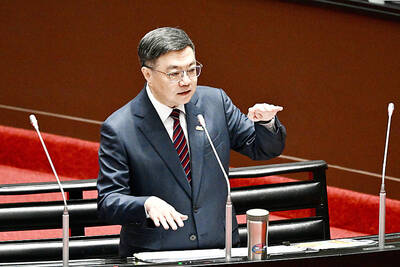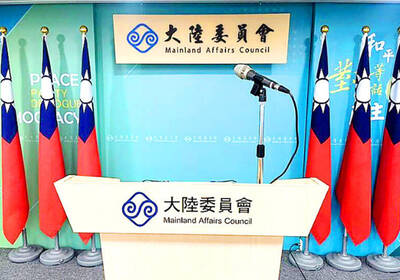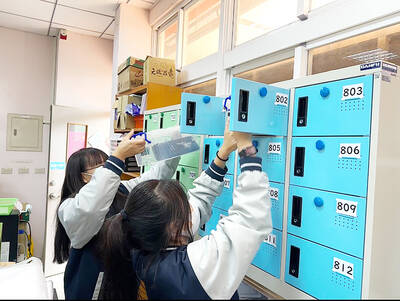Lebanon’s Hezbollah militant group yesterday said that it is entering a new phase in its fight against invading Israeli troops.
The group has introduced new weapons over the past few days, it said in a statement from its operations room.
Hezbollah’s fighters have used new types of precision-guided missiles and explosive drones for the first time, it said.

Photo: Reuters
The statement appears to refer to a drone laden with explosives that evaded Israel’s multilayered air-defense system and slammed into a mess hall at a military training camp in Israel, killing four soldiers and wounding dozens.
The group also announced earlier this week that it fired a new type of missile called Qader 2 toward the suburbs of Tel Aviv.
Hezbollah’s air defense units this week shot down two Israeli Hermes 450 drones, it said.
Hezbollah said its fighters are working according to “plans prepared in advance” to battle invading Israeli troops in several parts of south Lebanon.
Meanwhile, Hamas had not directly responded to an Israeli announcement that top Hamas leader Yahya Sinwar had been killed in a battle with Israeli forces in Gaza the previous day.
Israel is mistaken if it “believes that killing our leaders means the end of our movement and the struggle of the Palestinian people,” Hamas political bureau member Bassem Naim said.
“Hamas each time became stronger and more popular, and these leaders became an icon for future generations to continue the journey towards a free Palestine,” Naim said.
It is “painful and distressing to lose beloved people, especially extraordinary leaders,” but the Palestinian militant group is sure it will be “eventually victorious,” he said.
When asked if the statement was a confirmation of Sinwar’s death, Naim said it was not.
Many, from the governments of Israeli allies to residents of Gaza, expressed hope that Sinwar’s death would pave the way for an end to the war, but Israeli Prime Minister Benjamin Netanyahu said in a speech announcing the killing: “Our war is not yet ended.”

NATIONAL SECURITY: The Chinese influencer shared multiple videos on social media in which she claimed Taiwan is a part of China and supported its annexation Freedom of speech does not allow comments by Chinese residents in Taiwan that compromise national security or social stability, the nation’s top officials said yesterday, after the National Immigration Agency (NIA) revoked the residency permit of a Chinese influencer who published videos advocating China annexing Taiwan by force. Taiwan welcomes all foreigners to settle here and make families so long as they “love the land and people of Taiwan,” Premier Cho Jung-tai (卓榮泰) told lawmakers during a plenary session at the Legislative Yuan in Taipei. The public power of the government must be asserted when necessary and the Ministry of

CROSSED A LINE: While entertainers working in China have made pro-China statements before, this time it seriously affected the nation’s security and interests, a source said The Mainland Affairs Council (MAC) late on Saturday night condemned the comments of Taiwanese entertainers who reposted Chinese statements denigrating Taiwan’s sovereignty. The nation’s cross-strait affairs authority issued the statement after several Taiwanese entertainers, including Patty Hou (侯佩岑), Ouyang Nana (歐陽娜娜) and Michelle Chen (陳妍希), on Friday and Saturday shared on their respective Sina Weibo (微博) accounts a post by state broadcaster China Central Television. The post showed an image of a map of Taiwan along with the five stars of the Chinese flag, and the message: “Taiwan is never a country. It never was and never will be.” The post followed remarks

Proposed amendments would forbid the use of all personal electronic devices during school hours in high schools and below, starting from the next school year in August, the Ministry of Education said on Monday. The Regulations on the Use of Mobile Devices at Educational Facilities up to High Schools (高級中等以下學校校園行動載具使用原則) state that mobile devices — defined as mobile phones, laptops, tablets, smartwatches or other wearables — should be turned off at school. The changes would stipulate that use of such devices during class is forbidden, and the devices should be handed to a teacher or the school for safekeeping. The amendments also say

CONSISTENT COMMITMENT: The American Institute in Taiwan director said that the US would expand investment and trade relationships to make both nations more prosperous The US would not abandon its commitment to Taiwan, and would make Taiwan safer, stronger and more prosperous, American Institute in Taiwan Director Raymond Greene said. “The US’ commitment to Taiwan has been consistent over many administrations and over many years, and we will not abandon our commitment to Taiwan, including our opposition to any attempt to use force or coercion to change Taiwan’s status,” he said in an exclusive interview with the Liberty Times (the sister newspaper of the Taipei Times) on Friday last week, which was published in the Chinese-language newspaper yesterday. The US would double down on its efforts